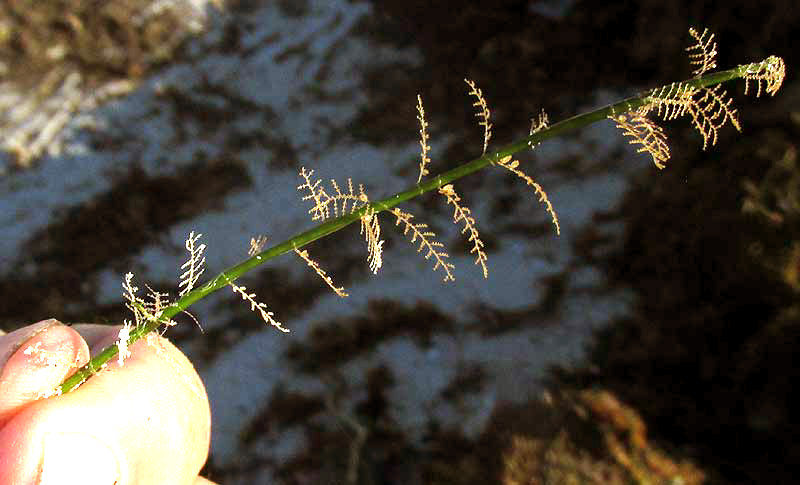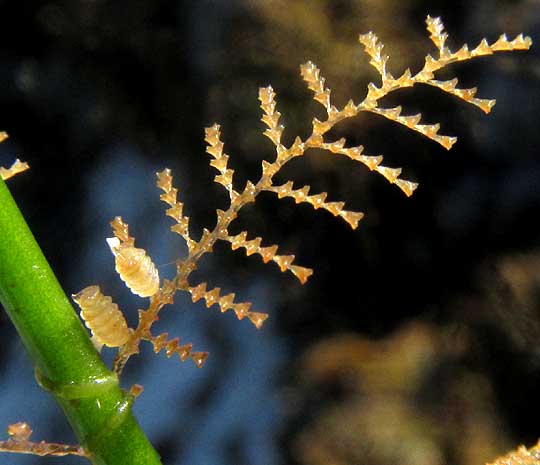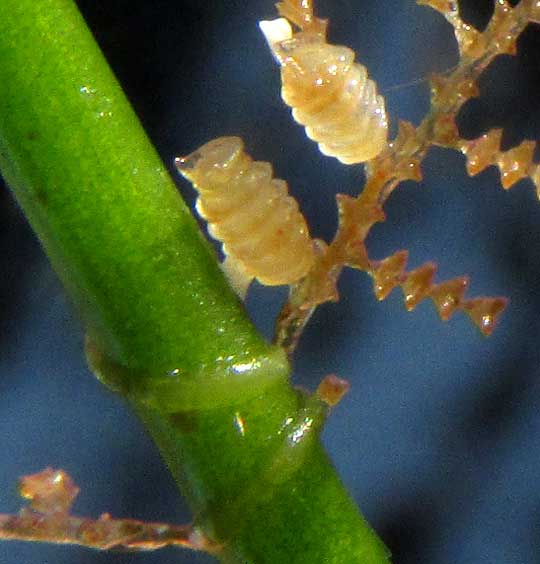Excerpts from Jim Conrad's
Naturalist Newsletter

from the December 28, 2014 Newsletter issued from Río Lagartos, on the Yucatan Peninsula's northern coast (~N21.60°, ~W88.16°), Yucatán state, MÉXICO
A FEATHERY HYDROID
On the Gulf of Mexico beach we were combing through seaweed heaped up by waves when my biologist friend Willi found something unlike anything either of us had ever seen. It was a small, slender, stiff, cylindrical, stem-like thing from which emerged pale, translucent, intricately feathery items, shown above.
It didn't make sense. The stem was clearly photosynthetic and containing a vascular network like a typical flowering plant, but the "leaves" seemed to lack chlorophyll and were so delicate and flimsy that surely they lacked xylem and phloem. The "stem" didn't have nodes from which leaves normally emerge, and the leaves were unequally spaced. Under magnification with a hand lens, the mystery only increased, as you can see below:

The "leaf" looks even more exquisite and at its base arise cone-like things held erect above the central stem. Moreover the base of the leaflike object's "petiole" seems to wrap around the green stem with some kind of transparent noose. A closer look at these otherworldly features is provided below:

Really at first I didn't know whether this was an animal or a plant, a fungus or an alga. I had to review the whole array of Life on Earth to get my bearings, and make sure I wasn't forgetting some obscure kind of life form capable of looking like this.
The first breakthrough was to realize that here we had two things. The stiff, green "stem" was actually a Manatee Grass leaf. The mystery organism attached itself to the Manatee Grass leaf with a transparent noose. The mystery item exhibited symmetry, so it wasn't something like a sponge. The cone-like items appear jellylike and translucent like something animal-based, not of plant origin. The "nooses" around the leaf were unlike anything an alga might create. Surely these were animals. On Caribbean beaches we've seen Bryozoa consisting of fan-like colonies of tiny animals, but no Bryozoa could be found looking like our discovery.
Reviewing the Tree of Life and seeing how the Bryozoa form a phylum -- phyla being the second big subdivision below the Kingdom of Animalia, the animals -- and disqualifying the various other animal phyla such as the sponges, the amoeba-like Placozoa, etc., finally nothing was left but the Cnidaria, the jellyfish phylum. What I hadn't realized until this review is that many Cnidaria are colonial, organizing themselves into colonies like the Bryozoa.
By doing an image search on the Internet of the many forms of Cnidaria, finally I found organisms looking like our find within the Class Hydrozoa -- the "hydrozoans," or "hydroids." The feathery structures on our Manatee Grass leaf were tiny, colonial hydroids.
*UPDATE: At this point ten years ago in 2014, I went astray in my efforts to identify this organism. Now in 2024, with many more identification resources on the Internet, when I upload the images to iNaturalist, the AI automatic identification tool suggests several options: it's first is a fern, the second a kind of grass, but down the list there's a hydroid, and not only that, it suggests a genus and species whose images look like our discovery. It's the Knotted Thread Hydroid, OBELIA GENICULATA.
Now in 2024, on iNaturalist, this species hasn't been recorded for Mexico, though GBIF mentions a rare occurrence. iNaturalist reports observations from scattered points through the world, so we might be adding something new here.